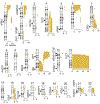Genetic Characterization and Prognostic Relevance of Acquired Uniparental Disomies in Cytogenetically Normal Acute Myeloid Leukemia
- PMID: 31375516
- PMCID: PMC6825549
- DOI: 10.1158/1078-0432.CCR-19-0725
Genetic Characterization and Prognostic Relevance of Acquired Uniparental Disomies in Cytogenetically Normal Acute Myeloid Leukemia
Abstract
Purpose: Uniparental disomy (UPD) is a way cancer cells duplicate a mutated gene, causing loss of heterozygosity (LOH). Patients with cytogenetically normal acute myeloid leukemia (CN-AML) do not have microscopically detectable chromosome abnormalities, but can harbor UPDs. We examined the prognostic significance of UPDs and frequency of LOH in patients with CN-AML.Experimental Design: We examined the frequency and prognostic significance of UPDs in a set of 425 adult patients with de novo CN-AML who were previously sequenced for 81 genes typically mutated in cancer. Associations of UPDs with outcome were analyzed in the 315 patients with CN-AML younger than 60 years.
Results: We detected 127 UPDs in 109 patients. Most UPDs were large and typically encompassed all or most of the affected chromosome arm. The most common UPDs occurred on chromosome arms 13q (7.5% of patients), 6p (2.8%), and 11p (2.8%). Many UPDs significantly cooccurred with mutations in genes they encompassed, including 13q UPD with FLT3-internal tandem duplication (FLT3-ITD; P < 0.001), and 11p UPD with WT1 mutations (P = 0.02). Among patients younger than 60 years, UPD of 11p was associated with longer overall survival (OS) and 13q UPD with shorter disease-free survival (DFS) and OS. In multivariable models that accounted for known prognostic markers, including FLT3-ITD and WT1 mutations, UPD of 13q maintained association with shorter DFS, and UPD of 11p maintained association with longer OS.
Conclusions: LOH mediated by UPD is a recurrent feature of CN-AML. Detection of UPDs of 13q and 11p might be useful for genetic risk stratification of patients with CN-AML.
Trial registration: ClinicalTrials.gov NCT00085124 NCT00742625 NCT00651261 NCT00006363 NCT00900224 NCT00048958 NCT00899223 NCT00003190.
©2019 American Association for Cancer Research.
Conflict of interest statement
Figures


Similar articles
-
Identification of acquired copy number alterations and uniparental disomies in cytogenetically normal acute myeloid leukemia using high-resolution single-nucleotide polymorphism analysis.Leukemia. 2010 Feb;24(2):438-49. doi: 10.1038/leu.2009.263. Epub 2009 Dec 17. Leukemia. 2010. PMID: 20016533
-
Prognostic implications of NPM1 mutations and FLT3 internal tandem duplications in Egyptian patients with cytogenetically normal acute myeloid leukemia.Hematology. 2014 Jan;19(1):22-30. doi: 10.1179/1607845413Y.0000000085. Epub 2013 Nov 25. Hematology. 2014. PMID: 23540998
-
Segmental uniparental disomy is a commonly acquired genetic event in relapsed acute myeloid leukemia.Blood. 2008 Aug 1;112(3):814-21. doi: 10.1182/blood-2008-01-132431. Epub 2008 May 19. Blood. 2008. PMID: 18490517
-
[FLT3 Mutations in Acute Myeloid Leukemia].Rinsho Byori. 2017 Jan;65(1):44-51. Rinsho Byori. 2017. PMID: 30695511 Review. Japanese.
-
The clinical relevance of Wilms Tumour 1 (WT1) gene mutations in acute leukaemia.Hematol Oncol. 2010 Mar;28(1):13-9. doi: 10.1002/hon.931. Hematol Oncol. 2010. PMID: 20013787 Review.
Cited by
-
Appraisal of current technologies for the study of genetic alterations in hematologic malignancies with a focus on chromosome analysis and structural variants.Med Genet. 2024 Mar 6;36(1):13-20. doi: 10.1515/medgen-2024-2001. eCollection 2024 Apr. Med Genet. 2024. PMID: 38835966 Free PMC article.
-
Cytogenetics analysis as the central point of genetic testing in acute myeloid leukemia (AML): a laboratory perspective for clinical applications.Clin Exp Med. 2023 Aug;23(4):1137-1159. doi: 10.1007/s10238-022-00913-1. Epub 2022 Oct 13. Clin Exp Med. 2023. PMID: 36229751 Review.
-
TSC22D3 as an immune-related prognostic biomarker for acute myeloid leukemia.iScience. 2023 Jul 22;26(8):107451. doi: 10.1016/j.isci.2023.107451. eCollection 2023 Aug 18. iScience. 2023. PMID: 37575189 Free PMC article.
-
Evolving Therapeutic Approaches for Older Patients with Acute Myeloid Leukemia in 2021.Cancers (Basel). 2021 Oct 11;13(20):5075. doi: 10.3390/cancers13205075. Cancers (Basel). 2021. PMID: 34680226 Free PMC article. Review.
-
Patterns and variations of copy number alterations in acute myeloid leukemia: insights from the LeukAtlas database.Leukemia. 2025 Apr;39(4):827-836. doi: 10.1038/s41375-025-02514-9. Epub 2025 Feb 2. Leukemia. 2025. PMID: 39894867
References
-
- Grimwade D, Mrózek K. Diagnostic and prognostic value of cytogenetics in acute myeloid leukemia. Hematol Oncol Clin North Am 2011;25(6):1135–61 - PubMed
-
- Dunbar AJ, Gondek LP, O’Keefe CL, Makishima H, Rataul MS, Szpurka H, et al. 250K single nucleotide polymorphism array karyotyping identifies acquired uniparental disomy and homozygous mutations, including novel missense substitutions of c-Cbl, in myeloid malignancies. Cancer Res 2008;68(24):10349–57 - PMC - PubMed
-
- Raghavan M, Lillington DM, Skoulakis S, Debernardi S, Chaplin T, Foot NJ, et al. Genome-wide single nucleotide polymorphism analysis reveals frequent partial uniparental disomy due to somatic recombination in acute myeloid leukemias. Cancer Res 2005;65(2):375–8 - PubMed
Publication types
MeSH terms
Substances
Associated data
Grants and funding
- U10 CA077658/CA/NCI NIH HHS/United States
- P30 CA016056/CA/NCI NIH HHS/United States
- U10 CA180821/CA/NCI NIH HHS/United States
- U10 CA180850/CA/NCI NIH HHS/United States
- UG1 CA233180/CA/NCI NIH HHS/United States
- UG1 CA233191/CA/NCI NIH HHS/United States
- U10 CA180833/CA/NCI NIH HHS/United States
- U10 CA180867/CA/NCI NIH HHS/United States
- R35 CA197734/CA/NCI NIH HHS/United States
- U10 CA180861/CA/NCI NIH HHS/United States
- UG1 CA233331/CA/NCI NIH HHS/United States
- U10 CA180882/CA/NCI NIH HHS/United States
- UG1 CA233338/CA/NCI NIH HHS/United States
- U24 CA196171/CA/NCI NIH HHS/United States
- P30 CA016058/CA/NCI NIH HHS/United States
- U10 CA180866/CA/NCI NIH HHS/United States
- UG1 CA233339/CA/NCI NIH HHS/United States
LinkOut - more resources
Full Text Sources
Medical
Miscellaneous

